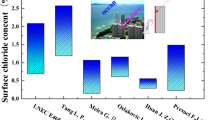Abstract
In order to study the durability behavior of marine reinforced concrete structure suffering from chloride attack, the structural service life is assumed to be divided into three critical stages, which can be characterized by steel corrosion and cover cracking. For each stage, a calculated model used to predict the lifetime is developed. Based on the definition of durability limit state, a probabilistic lifetime model and its time-dependent reliability analytical method are proposed considering the random natures of influencing factors. Then, the probabilistic lifetime prediction models are applied to a bridge pier located in the Hangzhou Bay with Monte Carlo simulation. It is found that the time to corrosion initiation t 0 follows a lognormal distribution, while that the time from corrosion initiation to cover cracking t 1 and the time for crack to develop from hairline crack to a limit crack width t 2 can be described by Weibull distributions. With the permitted failure probability of 5.0%, it is also observed that the structural durability lifetime mainly depends on the durability life t 0 and that the percentage of participation of the life t 0 to the total service life grows from 61.5% to 83.6% when the cover thickness increases from 40 mm to 80 mm. Therefore, for any part of the marine RC bridge, the lifetime predictions and maintenance efforts should also be directed toward controlling the stage of corrosion initiation induced by chloride ion.
Similar content being viewed by others
References
Ababneh, A., Benboudjema, F. and Xi, Y. P., 2003. Chloride penetration in nonsaturated concrete, J. Mater. Civil Eng., 15(2): 183–191.
Andrade, C. and Alonso, C., 1996. Corrosion rate monitoring in the laboratory and on-site, Constr. Build. Mater., 10(5): 315–328.
Apostolopoulos, C. A. and Papadakis, V. G., 2008. Consequences of steel corrosion on the ductility properties of reinforcement bar, Constr. Build. Mater., 22(12): 2316–2324.
Bastidas-Arteaga, E., Sanchez-Silva, M., Chateauneuf, A. and Silva, M. R., 2008. Coupled reliability model of biodeterioration, chloride ingress and cracking for reinforced concrete structures, Struct. Saf., 30(2): 110–129.
Bazant, Z. P., 1979. Physical model for steel corrosion in concrete sea structures-theory, J. Struct. Div., ASCE, 105(6): 1137–1153.
Canadian Standards Association (CSA), A23.3-04, 2004. Design of concrete structures, Canadian Standards Association, Mississauga, Canada.
Chen, D. and Mahadevan, S., 2008. Chloride-induced reinforcement corrosion and concrete cracking simulation, Cem. Concr. Compos., 30(3): 227–238.
Hong, H. P., 2000. Assessment of reliability of aging reinforced concrete structures, J. Struct. Eng., ASCE, 126(12): 1458–1465.
Jin, L. B., 2008. Multi-environmental time similarity theory and its application in coastal concrete structural durability, Ph.D Thesis, Zhejiang University, Hangzhou. (in Chinese)
Jin, W. L. and Jin, L. B., 2009. A multi-environmental time similarity theory of life prediction on coastal concrete structural durability, Int. J. Struct. Eng., 1(1): 40–58.
Kwon, S. J., Na, U. J., Park, S. S. and Jung, S. H., 2009. Service life prediction of concrete wharves with early-aged crack: Probabilistic approach for chloride diffusion, Struct. Saf., 31(1): 75–83.
Liu, Y. P. and Weyers, R. E., 1998. Modeling the time-to-corrosion cracking of the cover concrete in chloride contaminated reinforced concrete structures, ACI Mater. J., 95(6): 675–680.
Lu, C. H., Wang, H. L. and Jin, W. L., 2008. Modeling the influence of stress level on chloride transport in prestressed concrete, International Conference on Durability of Concrete Structures, 26–27, 239–245.
Lu, C. H., Jin, W. L. and Liu, R. G., 2011. Reinforcement corrosion-induced cover cracking and its time prediction for reinforced concrete structures, Corros. Sci., 53(4): 1337–1347.
Maaddawy, T. EI. and Soudki, K., 2007. A model for prediction of time from corrosion initiation to corrosion cracking, Cem. Concr. Compos., 29(3): 168–175.
Melchers, R. E., Li, C. Q. and Lawanwisut, W., 2008. Probabilistic modeling of structural deterioration of reinforced concrete beams under saline environment corrosion, Struct. Saf., 30(5): 447–460.
Pantazopoulou, S. J. and Papoulia, K D., 2001. Modeling cover-cracking due to reinforcement corrosion in RC structures, J. Eng. Mech., ASCE, 127(4): 342–351.
Samson, E. and Marchand, J., 2007. Modeling the effect of temperature on ionic transport in cementitious materials, Cem. Concr. Res., 37(3): 455–468.
Steward, M. G. and Mullard, J. A., 2007. Spatial time-dependent reliability analysis of corrosion damage and the timing of first repair for RC structures, Eng. Struct., 29(7): 1457–1464.
The European Union-Brite Euram III. DuraCrete, 2000. General Guidelines for Durability Design and Redesign, Document BE95-1347/R15, 14–29.
Thomas, M. D. A. and Bentz, E. C., 2002. Computer Program for Predicting the Service Life and Life-Cycle Costs of Reinforced Concrete Exposed to Chlorides, Life365 Manual, SFA.
Thoft-Christensen, P., 2000. Stochastic modeling of the crack initiation time for reinforced concrete structures, Proc., ASCE 2000 Structures Congress, ASCE, Philadelphia, 1–8.
Tikalsky, P. J., Pustka, D. and Marek, P., 2005. Statistical variations in chloride diffusion in concrete bridges, ACI Struct. J., 102(3): 481–486.
Torres-Acosta, A. A., Navarro-Gutierrez, S. and Teran-Guillen, J., 2007. Residual flexure capacity of corroded reinforced concrete beams, Eng. Struct., 29(6): 1145–1152.
Vu, K. A. T. and Stewart, M. G., 2005. Predicting the likelihood and extent of reinforced concrete corrosion-induced cracking, J. Struct. Eng., ASCE, 131(11): 1681–1689.
Wang, H. L., Jin, W. L. and Sun, X. Y., 2008. Fracture model for protective layer cracking of reinforced concrete structure due to rebar corrosion, Journal of Hydraulic Engineering, 39(7): 863–869. (in Chinese)
Yang, W. W., Qian, J. S. and Zhang, Y. Y., 2009. Effect of fly ash on frost-resistance and chloride ions diffusion properties of marine concrete, China Ocean Eng., 23(2): 367–377.
Zhao, Y. X. and Jin, W. L., 2006. Modeling the amount of steel corrosion at the cracking of concrete cover, Adv. Struct. Eng., 9(5): 687–696.
Author information
Authors and Affiliations
Corresponding author
Additional information
The paper was financially supported by the National Natural Science Foundation of China (Grant Nos. 50538087, 50908103 and 50878098).
Rights and permissions
About this article
Cite this article
Lu, Ch., Jin, Wl. & Liu, Rg. Probabilistic lifetime assessment of marine reinforced concrete with steel corrosion and cover cracking. China Ocean Eng 25, 305–318 (2011). https://doi.org/10.1007/s13344-011-0025-6
Received:
Revised:
Published:
Issue Date:
DOI: https://doi.org/10.1007/s13344-011-0025-6




